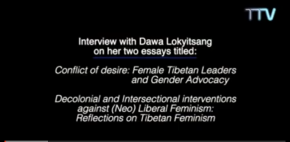by Dawa Lokyitsang
Over the course of few years, the Tibetan diaspora has seen a sharp rise in the number of Tibetan women who claim a feminist identity. What is Tibetan feminism, and how did it emerge? In the following, I track the rise of Tibetan feminism through the development of an online initiative called Tibetan Feminist Collective (TFC) based mostly in the west. Although TFC does not represent the diverse viewpoints of all women who identify as Tibetan and feminist, their version of feminism nonetheless becomes important to engage due to the initiative’s choice in leading and representing discussions regarding Tibetan feminism in Tibetan and non-Tibetan cyber and/or real worlds. Even though I use TFC as a Tibetan example of neoliberal feminism, they are not the only ones influenced by it. Other Tibetan women (alongside their male peers) not affiliated with TFC are also engaging neoliberal ideologies in shaping their individual pathways towards favorable professional outcomes that benefit themselves alone. Today we live in a world where the commodification of identities and activism, thanks to neoliberal ideologies, are so pervasive. Thus, it is important to think critically about the way neoliberalism shapes feminism (and other frameworks), and compromises their liberatory potential.









